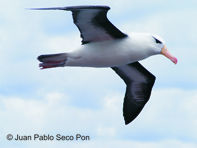Ewan Wakefield (British Antarctic Survey, Cambridge, UK) and colleagues write in the journal Proceedings of the Royal Society B on what regulates populations of Black-browed Albatrosses Thalassarche melanophris.
The paper’s abstract follows:
“Animal populations are frequently limited by the availability of food or of habitat. In central-place foragers, the cost of accessing these resources is distance-dependent rather than uniform in space. However, in seabirds, a widely studied exemplar of this paradigm, empirical population models have hitherto ignored this cost. In part, this is because non-independence among colonies makes it difficult to define population units. Here, we model the effects of both resource availability and accessibility on populations of a wide-ranging, pelagic seabird, the black-browed albatross Thalassarche melanophris. Adopting a multi-scale approach, we define regional populations objectively as spatial clusters of colonies. We consider two readily quantifiable proxies of resource availability: the extent of neritic waters (the preferred foraging habitat) and net primary production (NPP). We show that the size of regional albatross populations has a strong dependence, after weighting for accessibility, on habitat availability and to a lesser extent, NPP. Our results provide indirect support for the hypothesis that seabird populations are regulated from the bottom-up by food availability during the breeding season, and also suggest that the spatio-temporal predictability of food may be limiting. Moreover, we demonstrate a straightforward, widely applicable method for estimating resource limitation in populations of central-place foragers.”

Black-browed Albatross in flight, photograph by Juan Pablo Seco Pon
With thanks to Richard Phillips for information.
Reference:
Wakefield, E.D., Phillips, R.A. & Matthiopoulos, J. 2014. Habitat-mediated population limitation in a colonial central-place forager: the sky is not the limit for the black-browed albatross. Proceedings of the Royal Society B.
John Cooper, ACAP Information Officer, 22 January 2014

 English
English  Français
Français  Español
Español